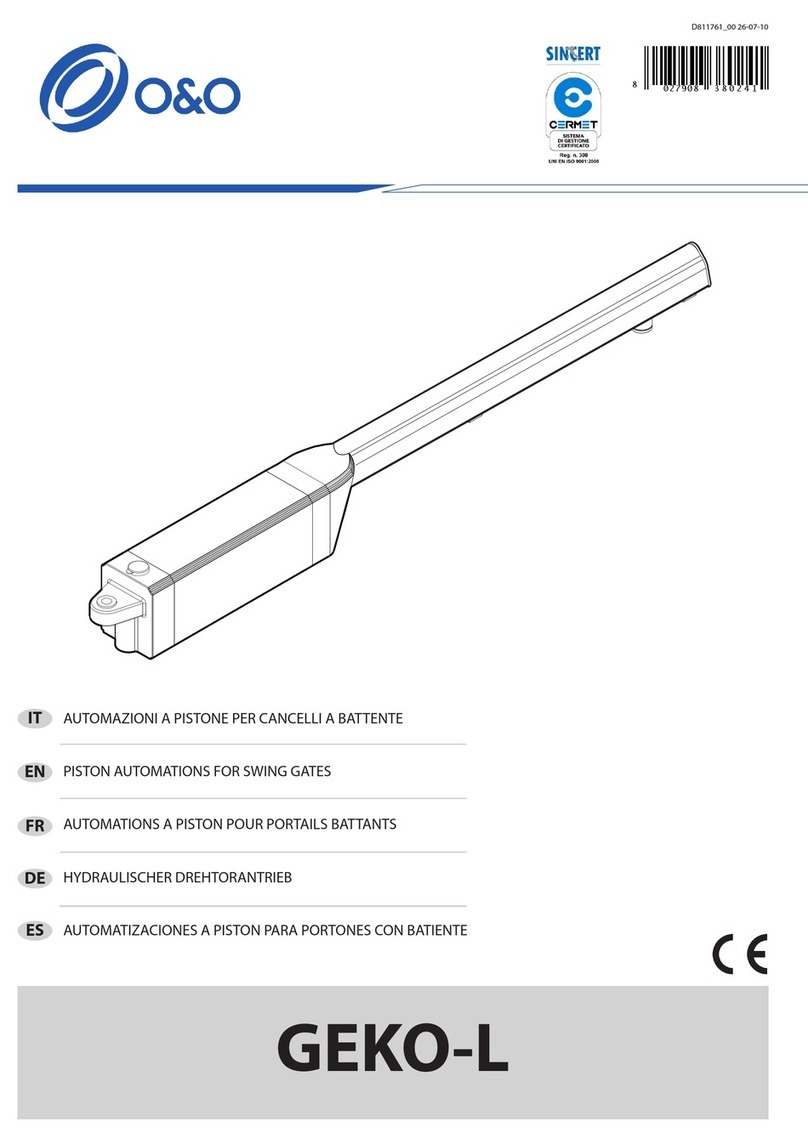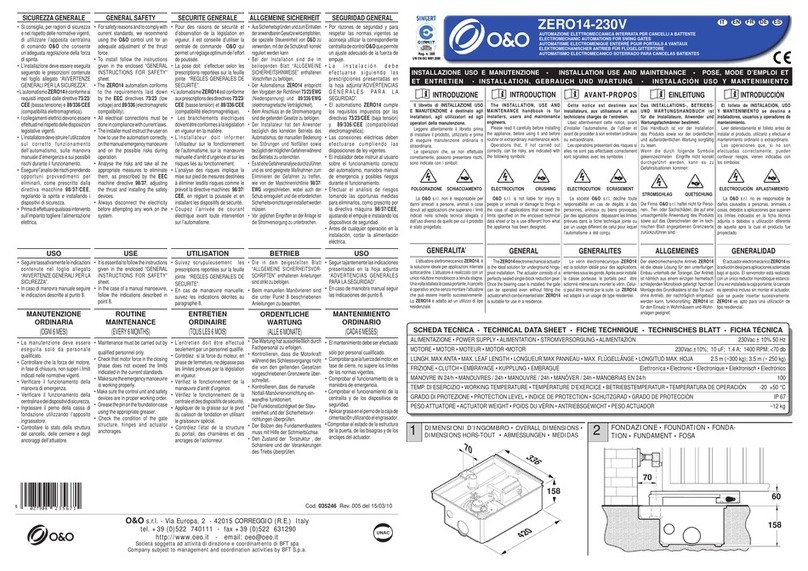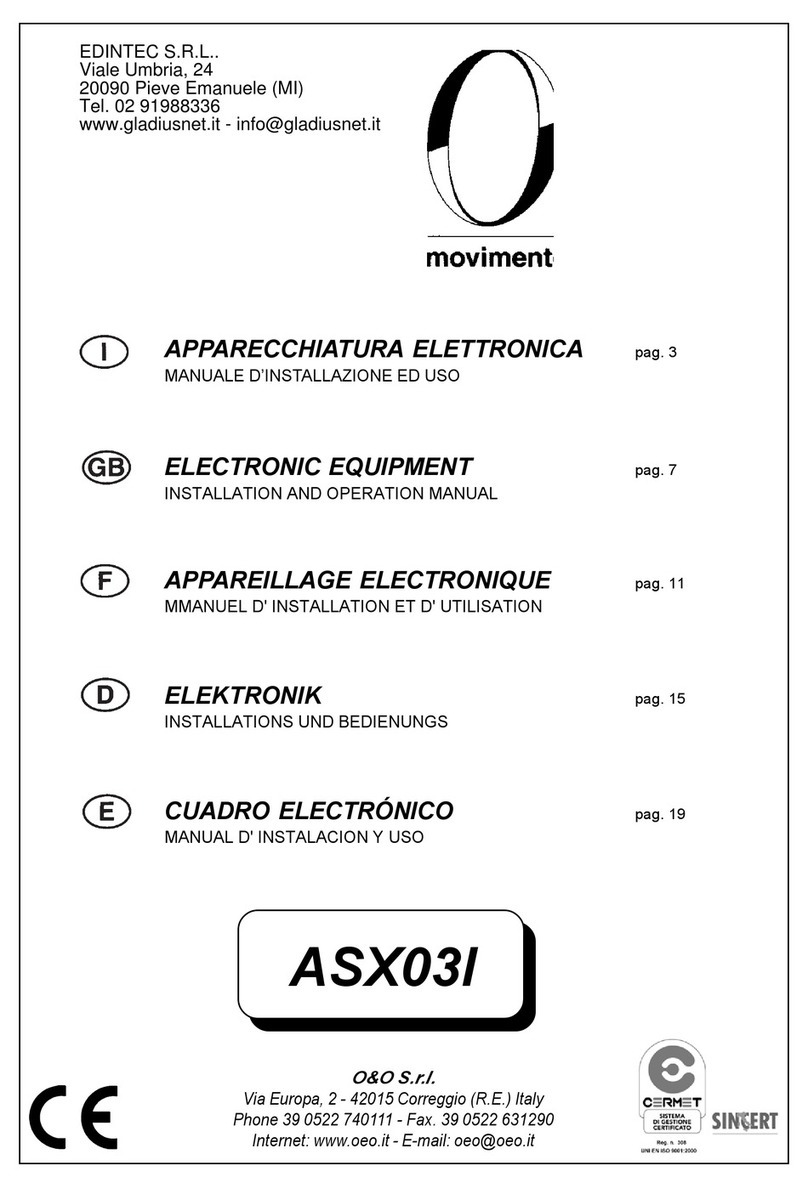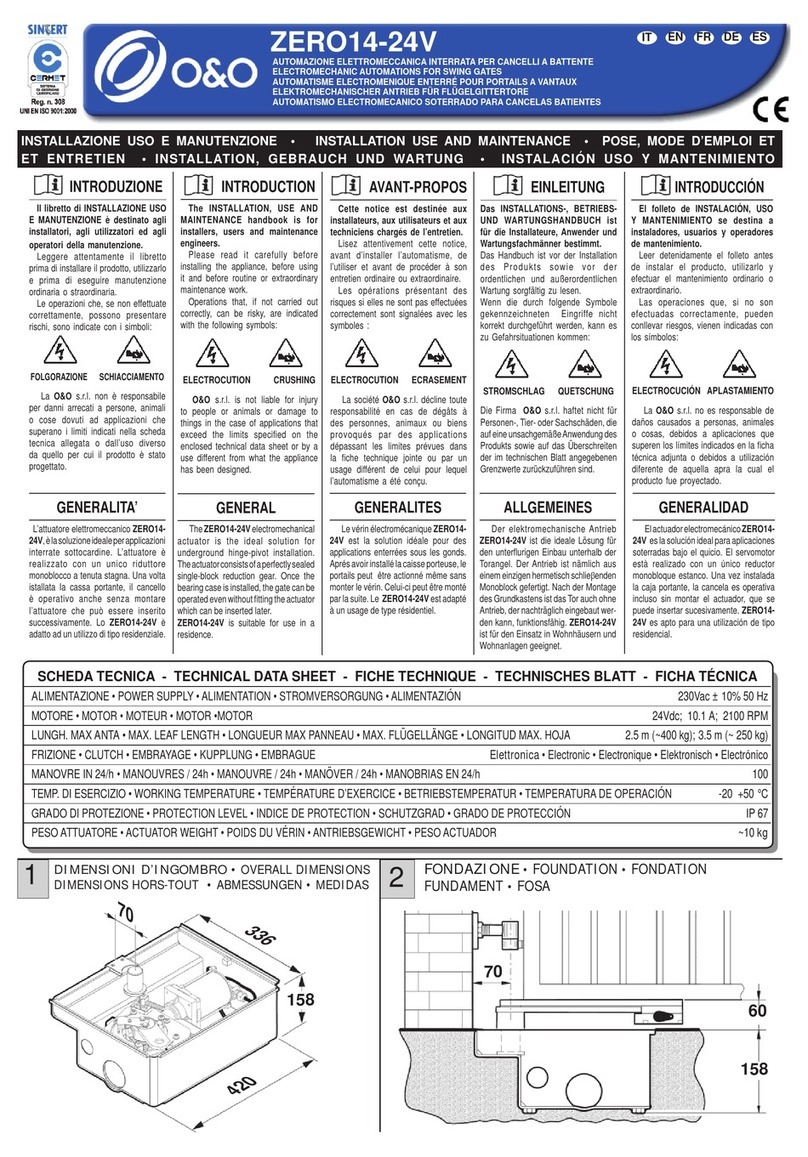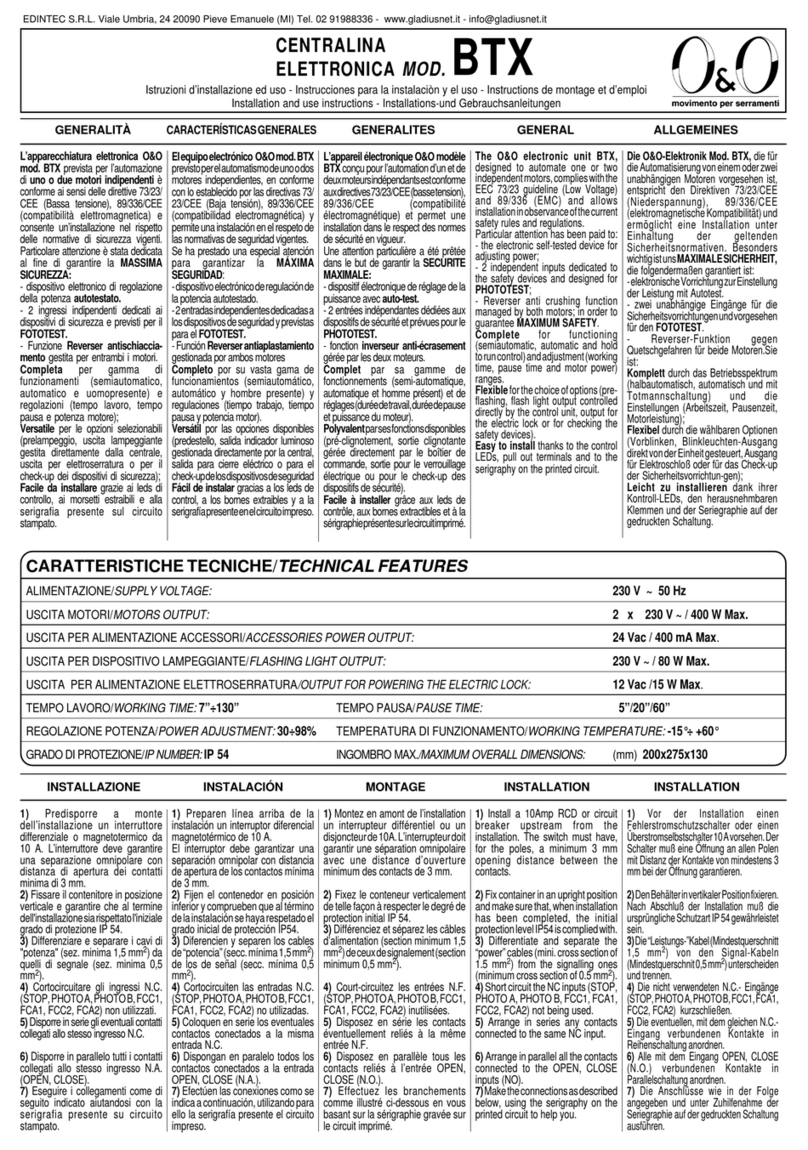
MANUALE PER L’INSTALLAZIONE ITALIANO
Nel ringraziarVi per la preferenza accordata a questo prodotto, la ditta è certa che
da esso otterrete le prestazioni necessarie al Vostro uso. Leggete attentamente
l’opuscolo “Avvertenze” ed il “Libretto istruzioni” che accompagnano questo
prodotto in quanto forniscono importanti indicazioni riguardanti la sicurezza,
l’installazione, l’uso e la manutenzione. Questo prodotto risponde alle norme
riconosciutedellatecnicaedelledisposizionirelativeallasicurezza.Confermiamo
che è conforme alle seguenti direttive europee: 2004/108/CEE, 2006/95/CEE (e
loro modiche successive).
1) SICUREZZA GENERALE
ATTENZIONE!Unainstallazioneerrataounusoimpropriodelprodotto,puòcreare
danni a persone, animali o cose.
• Leggeteattentamentel’opuscolo”Avvertenze”edil ”Librettoistruzioni”che
accompagnanoquestoprodotto,inquantofornisconoImportantiindicazioni
riguardanti la sicurezza, l’installazione, l’uso e la manutenzione.
• Smaltire i materiali di imballo (plastica, cartone, polistirolo, ecc.) secondo
quanto previsto dalle norme vigenti. Non lasciare buste di nylon e polistirolo
a portata dei bambini.
• Conservareleistruzioniperallegarlealfascicolotecnicoeperconsultazioni
future.
• Questoprodottoèstatoprogettatoecostruitoesclusivamenteperl’utilizzo
indicato in questa documentazione.
Usi non indicati in questa documentazione potrebbero essere fonte di danni
al prodotto e fonte di pericolo.
• LaDittadeclinaqualsiasiresponsabilitàderivantedall’usoimproprioodiverso
da quello per cui è destinato ed indicato nella presente documentazione.
• Noninstallareilprodottoinatmosferaesplosiva.
• Glielementicostruttividellamacchinadevonoessereinaccordoconleseguenti
Direttive Europee: 2004/108/CEE, 2006/95/CEE, 98/37 CEE e loro modiche
successive. Per tutti i Paesi extra CEE, oltre alle norme nazionali vigenti, per un
buon livello di sicurezza è opportuno rispettare anche le norme sopracitate.
• LaDittadeclinaqualsiasiresponsabilitàdall’inosservanzadellaBuonaTecnica
nella costruzione delle chiusure (porte, cancelli, ecc.), nonché dalle deforma-
zioni che potrebbero vericarsi durante l’uso.
• L’installazionedeveessereinaccordoconquantoprevistodalleDirettiveEu-
ropee: 2004/108/CEE, 2006/95/CEE, 98/37 CEE e loro modiche successive.
• Toglierel’alimentazioneelettrica,primadiqualsiasiinterventosull’impianto.
Scollegare anche eventuali batterie tampone se presenti.
• Prevederesullaretedialimentazionedell’automazione,uninterruttoreoun
magnetotermico onnipolare con distanza di apertura dei contatti uguale o
superiore a 3,5 mm.
• Vericarecheamontedellaretedialimentazione,visiauninterruttoredie-
renziale con soglia da 0.03A.
• Vericare se l’impianto di terra è realizzato correttamente: collegare tutte
le parti metalliche della chiusura (porte, cancelli, ecc.) e tutti i componenti
dell’impianto provvisti di morsetto di terra.
• Applicaretuttiidispositividisicurezza(fotocellule,costesensibili,ecc.)ne-
cessari a proteggere l’area da pericoli di schiacciamento, convogliamento,
cesoiamento.
• Applicarealmenoundispositivodisegnalazioneluminosa(lampeggiante)in
posizione visibile, ssare alla struttura un cartello di Attenzione.
• LaDitta declina ogniresponsabilità aini della sicurezzae del buonfun-
zionamento dell’automazione se vengono impiegati componenti di altri
produttori.
• Usareesclusivamentepartioriginaliperqualsiasimanutenzioneoriparazio-
ne.
• Noneseguirealcunamodicaaicomponentidell’automazionesenonespres-
samente autorizzata dalla Ditta.
• Istruirel’utilizzatoredell’impiantoperquantoriguardaisistemidicomando
applicati e l’esecuzione dell’apertura manuale in caso di emergenza.
• Nonpermettereapersoneebambinidisostarenell’aread’azionedell’auto-
mazione.
• Non lasciare radiocomandi o altri dispositivi di comando alla portata dei
bambini onde evitare azionamenti involontari dell’automazione.
• L’utilizzatoredeve evitare qualsiasi tentativodi interventoo riparazione e
rivolgersi solo a personale qualicato.
• Tuttoquellochenonèespressamenteprevistoinquesteistruzioni,nonè
permesso.
2) GENERALITA’
Pistoneelettromeccanicoprogettatoperautomatizzarecancelliditiporesidenziale.
Il motoriduttore irreversibile, mantiene il blocco in chiusura ed apertura senza
necessità di elettroserratura.
L’attuatoreè provvistodi limitatoredi coppiaelettronico.Deveesserecomandato
da un quadro comandi elettronico dotato di regolazione di coppia. Il funziona-
mento a ne corsa è regolato da due necorsa magnetici.
L’attuatoreè provvistodiun sistemadirilevamentoostacoli secondolenormative
EN12453 e EN 12445.
L’installazione deve essere fatta utilizzando dispositivi di sicurezza e comandi
conformi alla EN 12978
Sono disponibili i seguenti accessori opzionali:
- Kit batteria tampone mod. KIT-BATT-BT
Consente il funzionamento dell’automazione anche se manca per un breve
periodo l’alimentazione di rete.
3) DATI TECNICI
3.1) GEKO-S
Alimentazione : ............................................................................................................. 24V d.c.
Giri motore :...............................................................................................................3800 min -1
Potenza assorbita :..............................................................................................................40 W
Corrente assorbita :.............................................................................................................1.5 A
Forza di spinta e trazione : ...........................................................................................2000 N
Corsa utile : ..................................................................................................................... 280 mm
Velocità stelo :.....................................................................................................14 mm/s circa
Reazione all’urto :...........
Limitatore di coppia integrato su quadro di comando LOG-GK
Finecorsa: ......................................................................Magnetici incorporati e regolabili
Manovra manuale :....................................................................................Chiave di sblocco
N° manovre in 24ore : ..........................................................................................60 manovre
Massima lunghezza anta : .......................................................................................1800 mm
Massimo peso anta :.................................................................................................... ~250 kg
Condizioni ambientali : ........................................................................... da -15 °C a +60 °C
Grado di protezione : ......................................................................................................... IP 44
Dimensioni :.............................................................................................................Vedere g.1
Peso operatore :.................................................................................................................. ~5kg
Lubricazione :........................................................................................grasso permanente
3.2) KIT BATTERIE KIT-BATT-BT
Tensione di carica:......................................................................................................27.2V d.c.
Corrente di carica: .......................................................................................................... 130mA
Dati rilevati alla temperatura esterna di:......................................................................25°C
Capacità batteria: .............................................................................................2x (12V 1.2Ah)
Soglia protezione batteria scarica:..........................................................................20.4Vdc
Tempo di ricarica batteria:...........................................................................................12/14 h
4) INSTALLAZIONE DELL’ATTUATORE
4.1) Veriche preliminari
Controllare:
• Chelastrutturadelcancellosiasucientementerobusta.
• Inognicaso,l’attuatoredevespingerel’antainunpuntorinforzato.
• Cheleantesimuovanomanualmenteesenzasforzopertuttalacorsa.
•
Che siano installate le battute d’arresto delle ante sia in apertura che in chiusura.
• Seilcancellononèdinuovainstallazione,controllarelostatodiusuraditutti
i componenti.
• Sistemareosostituirelepartidifettoseousurate.L’adabilitàelasicurezza
dell’automazione è direttamente inuenzata dallo stato della struttura del
cancello.
In g.2, è riportato lo schema a cui fare riferimento per l’installazione e la tabella
delle misure per il ssaggio a pilastro.
Lo schema di g.2 utilizza le seguenti convenzioni:
P staa posteriore di ssaggio al pilastro
F forcella anteriore di ssaggio dell’anta
a-b quote per determinare il punto di ssaggio della staa “P”
C valore dell’interasse di ssaggio (C = 993mm)
D lunghezza del cancello
X distanza dall’asse del cancello allo spigolo del pilastro
Z valore sempre superiore a 45 mm (b - X)
kg peso max dell’anta
α° angolo d’apertura dell’anta
4.2) Come interpretare la tabella delle misure di installazione
Dalla tabella è possibile scegliere valori di“a”e“b”in funzione dei gradi α° di aper-
tura che si desiderano ottenere. Sono evidenziati il valore di“a” e di “b”ottimale
per una apertura di α° = 90° a velocità costante.
Se si utilizzano valori di“a”e“b”troppo diversi tra loro, il movimento dell’anta non
è costante e la forza di trazione o spinta varia durante il movimento.
Per rispettare la velocità di apertura e garantire un buon funzionamento dell’ope-
ratore è opportuno che i valori“a”e “b”siano poco diversi tra loro.
Con valori max di“a” e “b”, il pistone sviluppa la massima forza.
Latabella èstataricavataper uncancellomedio dispessore 40mm.Vericare
sempre che non ci siano collisioni tra cancello ed attuatore.
4.3) Accorgimenti per installazioni particolari
Ing.3èillustrataunainstallazioneconnicchiaquandononc’èspaziosuciente






